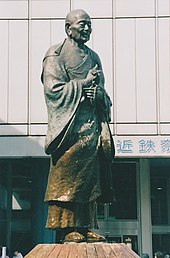Gyōki

Gyōki or Gyōgi ( Japanese 行 基 ; * 668 in the province of Kawachi ; † 749 ) was a Buddhist monk of the Japanese Hossō-shū . He is particularly famous for his charitable activities among the common people.
Gyōki, who came from a naturalized family of Korean nobles from Baekje , spent his life at Buddhist temples from the age of 15, first at Asuka-dera , then from 685 at Yakushi-ji , where he ordained at 24 and, among other things, was a student of Dōshō (629–700) and Gien ( 義 淵 ; 644–728).
In 704, Gyōki's mother fell ill, whereupon he left the Yakushi-ji and returned home, where he converted the apartment into a temple. He later moved with his mother to a hermitage on Mount Ikoma-yama , where they lived together until their death. Gyōki then began to travel the country on his own as a preacher and missionary.
In the course of his travels, Gyōki worked on a variety of construction projects, especially for the benefit of ordinary people - including landing stages, bridges, dams, irrigation systems, wells and hostels. The knowledge to do so most likely resulted from his studies at Dōshō. In total, he is also responsible for building 49 temples (34 for monks, 15 for nuns). Perhaps in connection with these trips, the map of Japan that bears his name was created.
Gyōki's travel activities were in blatant contradiction to the religious policy of the Ritsuryō nobility at the time. Sōni-ryō ( 僧尼 令 ), the activities of monks and priests outside of officially recognized temples and institutions, was forbidden . Edicts against Gyōki's illegal activities have been issued regularly since 718. Even in a passage from the Rikkokushi Shoku Nihongi , he was characterized as a dangerous seducer of the masses, although by this time he had long been accepted by various government officials.
In 721 he was invited by the Genshō - tennō to give a lecture at court, and he was officially allowed to ordain two of his followers. Later he developed close relationships with the Shōmu -tennō, who in 745 appointed him the first Daisōjō (about "Grand Rectifier"), the highest Buddhist office. He is said to have been involved in the construction of the Daibutsu at Tōdai-ji at the instigation of the imperial court .
Gyōki's work made him extremely popular during his lifetime. The Shoku Nihongi gives several examples in which he publicly ordained the masses, so 705 laypeople at a time in 741. At the time of his death Gyōki is said to have had over three thousand disciples, including Gyōshin (670-740) and Shōgo or Shōgu ( 732-811). His body was buried in the grounds of a temple on Ikoma-yama.
Posthumously Gyōki was even given the title of Bosatsu ( Bodhisattva ) by the imperial court . His reverence in popular Buddhism in Japan continues to this day.
Remarks
- ↑ The oldest surviving map of this type dates from the 13th century. The capital of Japan had meanwhile been moved from Nara to Kyoto.
literature
- Augustine, Jonathan Morris: Buddhist hagiography in early Japan: images of compassion in the Gyõki tradition. Abingdon: Routledge Shorton, 2005. ( Routledge Shorton studies in Asian religion ). ISBN 0-415-32245-6 . [English]
- Unno, Kazutaka : Japan cards for prayer rites and as a talisman. In: Cartographica Helvetica Heft 10 (1994) pp. 20–23 full text [Gyōki as map author]
| personal data | |
|---|---|
| SURNAME | Gyōki |
| ALTERNATIVE NAMES | 行 基 (Japanese); Gyogi |
| BRIEF DESCRIPTION | Buddhist monk of the Japanese Hossō-shū |
| DATE OF BIRTH | 668 |
| PLACE OF BIRTH | Kawachi Province |
| DATE OF DEATH | 749 |

